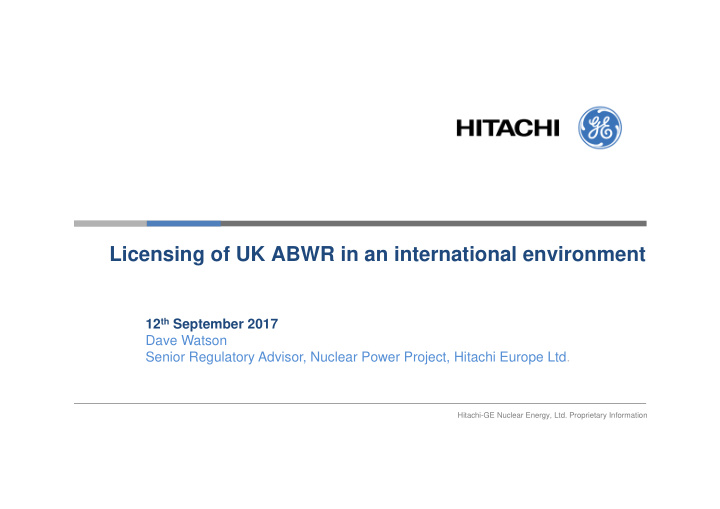



XE ‐ GD ‐ 0134 Rev.0 Licensing of UK ABWR in an international environment 12 th September 2017 Dave Watson Senior Regulatory Advisor, Nuclear Power Project, Hitachi Europe Ltd. Hitachi-GE Nuclear Energy, Ltd. Proprietary Information
Introduction Hitachi introduced Boiling Water Reactor (BWR) technology BWR1 to Japan, building on US experience, in the 1950s. BWR2 BWR technology has since been developed through successive generations of design – with construction more- or-less continual from 1970s to now. BWR3 Design evolution during this time has culminated in the BWR4 Advanced Boiling Water Reactor (ABWR). BWR5 The UK Advanced Boiling Water Reactor (UK ABWR) is BWR6 proposed for deployment in the UK, and Hitachi-GE is seeking regulatory design approval – a Design Acceptance Confirmation (DAC) and Statement of Design Acceptability (SoDA) for the design. ABWR Hitachi-GE Nuclear Energy, Ltd. Proprietary Information 1
ABWR Overview Benefits from proven construction and operating experience – safe, reliable and cost competitive Proven design: 4 operational, 4 under construction 4 units constructed on time and on budget in Japan Simplified systems with high operability UK ABWR design includes latest international developments, as well as refinements to meet specific UK conditions – but remains an ABWR. World-class safety features Hitachi-GE Nuclear Energy, Ltd. Proprietary Information 2
Safety features of the UK ABWR Defence in depth design– multiple safety trains and back-ups Core cooling: diverse methods of cooling o water supply Containment: multiple layers – fuel cladding, o RPV and RCCV Control: control rods fast acting to shut down o the reactor plus back-up liquid control system Enhanced C&I system & HWBS Visit our website and view the UK ABWR safety video: Aircraft impact protection http://www.hitachi-hgne-uk-abwr.co.uk/reactor-safety.html Extreme hazard protection from independent Back-up Building Hitachi-GE Nuclear Energy, Ltd. Proprietary Information 3
Fukushima Countermeasures Lessons learnt from Fukushima include: Earthquake Protection: Seismically qualified buildings Site layout: Elevated site plus option to site backup buildings on raised ground Protection of core facilities : watertight buildings and doors around backup features Loss of cooling and loss of off-site Visit website for further information on Fukushima learnings: power: additional diverse and independent http://www.hitachi-hgne-uk-abwr.co.uk/reactor-safety.html methods of power supply and core cooling Hitachi-GE Nuclear Energy, Ltd. Proprietary Information 4
UK ABWR Update - GDA Generic Design Assessment (GDA) is a challenging review by UK nuclear regulators Examines safety, environmental protection, security Takes significant effort Transparent process – reports published plus a public comments process Aim is to complete assessment while design is still ‘on paper’ A number of design changes have been made to meet UK regulatory expectations Hitachi-GE Nuclear Energy, Ltd. Proprietary Information 5
UK ABWR Update – site deployment GDA target completion is end of 2017 Horizon Nuclear Power (a 100% Hitachi subsidiary) has plans to deploy the UK ABWR at Wylfa Newydd and Oldbury-on-Severn. Will be twin units at each site Nuclear Site Licence application made Working to build UK domestic expertise – University seminars and support for BWR research hub Hitachi-GE Nuclear Energy, Ltd. Proprietary Information 6
Influences of International Licensing BWRs are deployed in many countries world-wide. Licensing by different regulatory regimes has undoubtedly contributed to design development and safety improvement. ABWR has undergone regulatory assessment in 4 countries. Visit our website and view the UK ABWR safety video: http://www.hitachi-hgne-uk-abwr.co.uk/reactor-safety.html Hitachi-GE Nuclear Energy, Ltd. Proprietary Information 7
Influences of MDEP MDEP has existed for around 10 years There is a design specific ABWR working group – this helps the regulators share information and learn from each other We believe MDEP does influence the UK regulator – and in turn that has an influence on their assessment as we progress through GDA No doubt that MDEP is positive for getting international regulators to work more closely together This is helping encourage common approaches (eg MDEP Common Positions) which will ultimately encourage international harmonisation of approaches for new reactor assessment. Hitachi-GE support further work to harmonise international regulation of new reactors. Hitachi-GE Nuclear Energy, Ltd. Proprietary Information 8
Summary – UK ABWR licensing in an international environment BWR technology has been developed through successive generations of design – with construction more-or-less continual from 1970s to now Design evolution during this time has resulted in the proven Advanced Boiling Water Reactor (ABWR) Generic Design Assessment for UK ABWR target is to complete end 2017 ABWR design has been influenced by international developments e.g. introduction of Fukushima learning and aircraft impact protection Hitachi-GE believes international cooperation via MDEP benefits regulation of new nuclear power plants Hitachi-GE supports the MDEP initiative and encourages continued progress on international harmonisation of approaches to regulation Hitachi-GE Nuclear Energy, Ltd. Proprietary Information 9
Hitachi-GE Nuclear Energy, Ltd. Proprietary Information 10 10
Recommend
More recommend